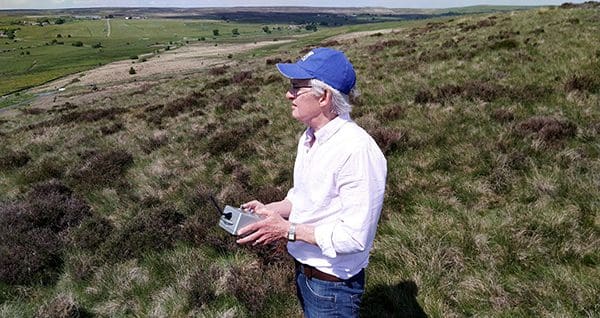Shaun Garrity’s starts this month’s retro column with a tribute to one of the greats of R/C helicopter manufacturing.
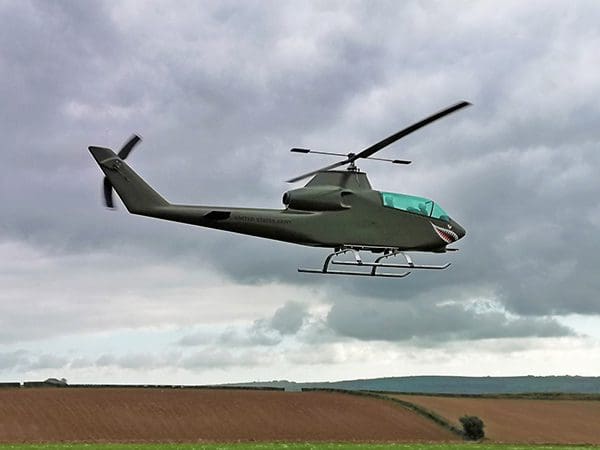
words >> Shaun Garrity
photos >> Shaun Garrity, Pete Christy
Enjoy more RCM&E Magazine reading every month.
Click here to subscribe & save.
By now many of us will have been back at the flying field making up for lost stick (or button) time. The BMFA Northern Area Flight Fest event, held on the 10th and 11th June, was testament to this. It was heart warming to see a group of modellers doing what they love – flying.
The ‘Bring & Buy’ was no disappointment either; dozens of tables stacked high with bargains and, yes, I did resist buying any more ‘pigs ear’ projects, even though I was sorely tempted by a number of aircraft. I’m sure the last Ramblings article helped with my junk acquiring urges after publicly admitting I had a ‘problem’.
More early heli chat
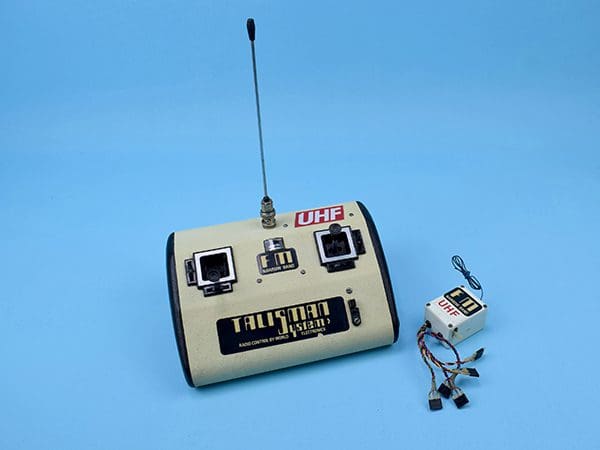
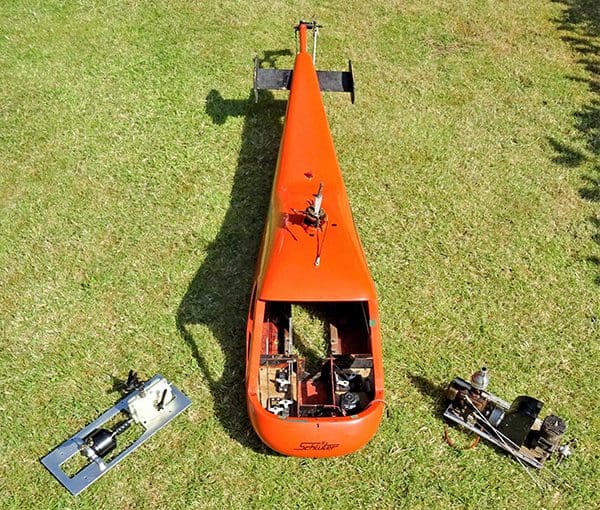
A few issues ago I penned a piece on retro helicopters and since then sadly another great modeller has passed away. I received the following from Pete Christy, who has championed saving and restoring these early examples of egg beating whirliness! His knowledge of retro heli’s is extensive and impressive; even better he’s not afraid of flying these rare models – no hangar queens in his collection.
“Hearing that Dieter Schluter, the generally acknowledged ‘father’ of R/C helicopters, had passed away in June, I thought you might like an update on my Schluter restorations and a short history lesson!
Following my successful resurrection, and conversion to electric, of John Haytree’s Schluter Cobra (John was for many years a well-regarded supplier of a wide range of replacement common and obscure model engine spares), I turned my attention to the DS-22 that I acquired in 2002 after having been contacted by a workmate who asked if I could have a look at his dad’s UHF R/C system as it had stopped working. The father lived quite close and the set in question turned out to be a World Engines 459 MHz set, which I had designed. The problem was quickly diagnosed as dead cells in the battery packs and a new set of batteries quickly restored full functionality (I wish all repairs were that easy). The father, having been told of my interest in helicopters, asked if I wanted a heli as payment. I must admit I hesitated; I have been offered some real rubbish in payment in the past but was somewhat gob-smacked when he produced a DS-22. I did tell him that even though the mechanics were in very poor condition, it was worth more than a set of batteries and a couple of hours of my time. However, he insisted that he wanted it to go to a good home and see it flying again.
By good fortune, some years earlier I had owned a 3rd or 4th hand Schluter Gazelle – the last Schluter design to use the ‘flat-bed’ mechanics. The fuselage was long away for a rainy day. It didn’t take long to fit my mechanics and within a couple of weeks the DS-22 was flying again for the first time in decades! I took the father up to our local field and he was ecstatic to see it airborne again. From another session at the Autumn Charmouth Fly-In that year there is some fairly grainy footage of it flying at that event here: https://youtu.be/bH2_W-PjjYE
The motor sounds a bit rough as I had forgotten that the rear-induction HP61 did NOT like nitro. Luckily, this DS-22 had been retro fitted with the collective pitch system from the Gazelle (Schluter’s first collective pitch model), so once the engine got over its transition to above half throttle it flew really well. I only used to fly it on special occasions in deference to its age, but the last few times the handling had deteriorated to the point where it was almost un-flyable, so it was retired again.
Then, following on from my experience with the Cobra, I decided to resurrect it with e-power. The conversion to electric was very simple and done in such a way that it would be possible to revert to IC power if desired. My first effort on the Cobra involved making the motor mounts out of bits of angled aluminium from B&Q. Crude, but it worked. For the DS-22, my old flying buddy Geoff Bell, an experienced metal worker, offered to make me a proper mount. The result was the beautifully machined mount seen in the pictures! In truth, it’s somewhat over-engineered, but that’s in keeping with Schluter’s philosophy for the rest of the machine (oil filled gearbox). The battery fitted in neatly where the fuel tank had been, making the C of G spot on. Unfortunately, although it hovered OK, (https://youtu.be/rAtZA5qcees), trying to fly it around almost ended in disaster as it was almost uncontrollable in forward flight.
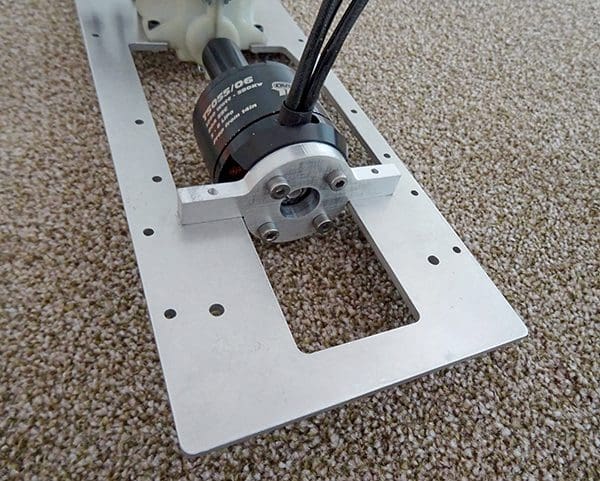
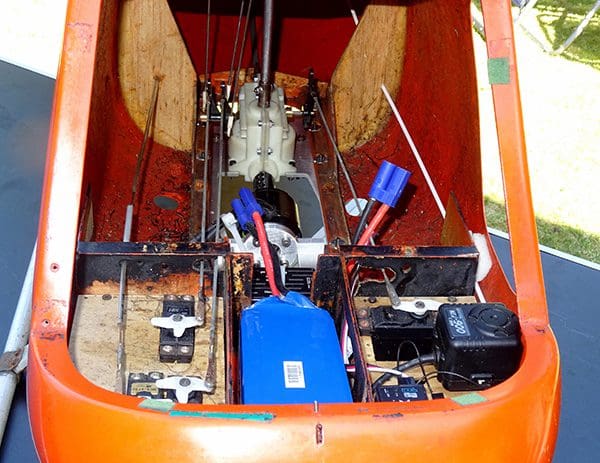
A close examination of the rotor-head revealed an awful lot of slop due to wear over the decades, requiring substantial remedial work. The original 8mm rotor shaft was stepped down to 7mm at the top to fit into the head. First, I reamed out the head-adapter from 7mm to 8mm. Next, Geoff came to the rescue again and made me a new rotor shaft without the step at the top; that got rid of about half the slop. The rest came from the teeter restraint bolts, which had elongated the holes in the head adapter. I reamed these out from 3 to 4mm and then inserted brass sleeves that were a tight press fit in the adapter but had a 3mm internal diameter for the bolts. The original rubber dampers were replaced with hard servo grommets. Finally, I also placed a thick sleeve over the teeter axle between the two sides of the adapter, to prevent this being squashed inwards when the teeter restraining bolts were tightened.
Following all these modifications, the handling was transformed, and it was back to its old self, as it had been when I first acquired it. It flies really nicely now, and I hope to fly it at the Pontefract retro meet.
Schluter made three helicopters based on the ‘flat-bed’ mechanics, a system also copied by Kalt and Hirobo in Japan for their early helicopters. The first was the prize-winning (and fixed pitch) Cobra – the first successful R/C helicopter. This was followed by the DS-22, also initially fixed pitch but fitted with a ‘flapping hinge’ rotor head, allegedly to make it easier to fly. Remember, these were VERY expensive and large machines back in the day and you had to learn from scratch with them. There was no-one around to help you.
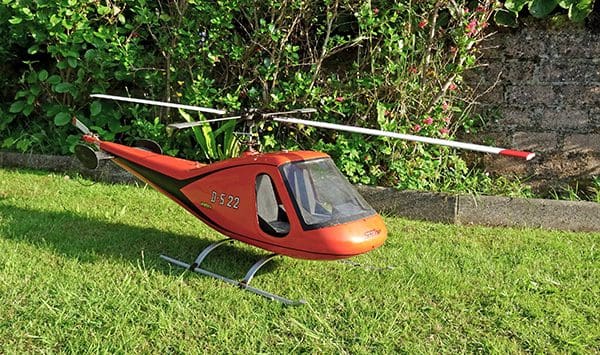
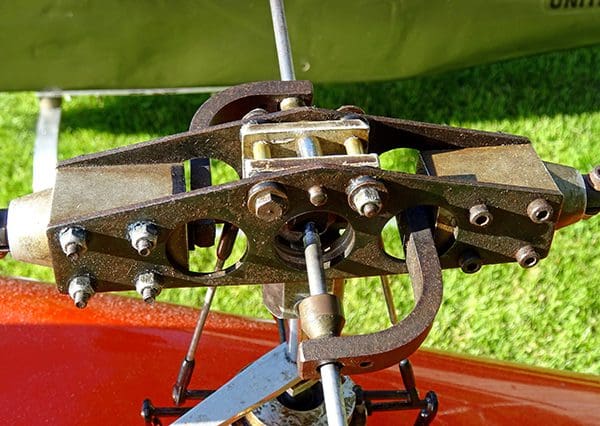
The last in the series was the Gazelle, which was also available with a collective pitch head. This head was also sold separately and could be retro-fitted to the Cobra and DS-22. After the Gazelle, Schluter designed the HeliBoy and HeliBaby, with essentially the same mechanics, differing only in the size of the rotor blades and the tail boom. These were the first helicopters to use a vertically mounted engine and a single stage reduction for the main gears. This layout is now almost universally adopted by all model helicopters and gives an idea of how ahead of his time Dieter Schluter really was.
As a final aside, I now have two of Schluter’s original designs in full flying order. I have enough bits to build a Gazelle, the last in the series, except for one item – a Schluter ‘Expert’ rotor head, as seen on my DS-22. If anyone has one of these kicking around in a dusty drawer somewhere, I would be very interested in buying it.”
If anybody can help Pete out with the Expert rotor head, so he can get his Gazelle airborne again, please email me and I’ll pass on your details. You will make him very happy. As the old saying goes, one person’s junk is another’s treasure, eh!
Dennis Allan, engine maestro
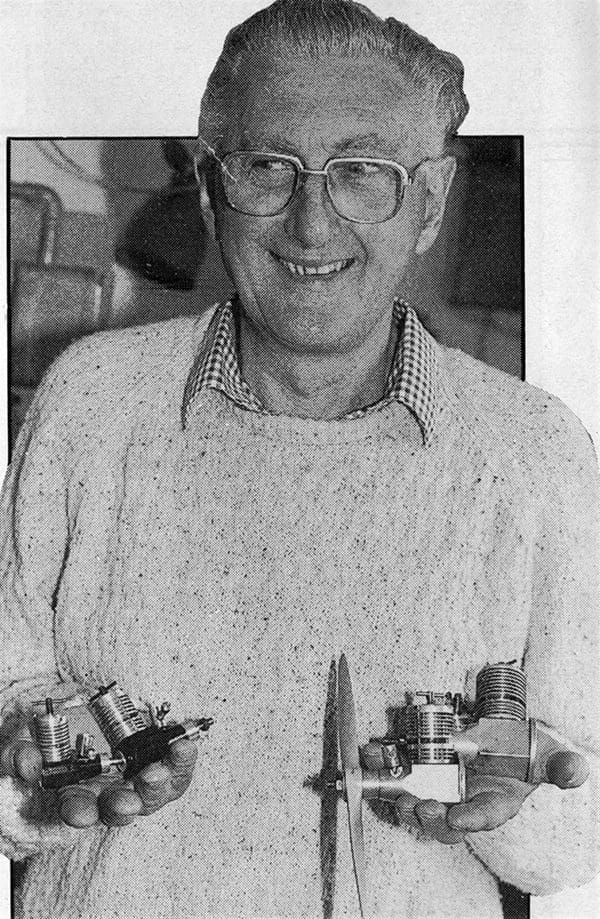
Having covered a few other UK diesel manufacturers in the past I thought I would take a quick look at the manufacturer of one of the first big engines I owned, the AM 35 – yes, all of 3.5cc!
Like many modellers of his era Dennis started modelling aged nine with the de-rigueur rubber powered models and became adept at trimming and flying them. Dennis went into the forces, so this effectively curtailed his modelling activities. I remember reading that when his period of active duty was fulfilled and he rejoined Civvy Street his first modelling purchase was an Ohlsson 60. Dennis met up with a fellow demobbed modeller called Ron Moulton. Ron became a very well-respected modeller and the face of Aeromodeller for many, many years. He was also, from memory, credited with introducing control line flying to the UK.
Dennis, after seeing Ron fly control line, went home and designed a suitable charge for the Ohlsson. After mastering control line, he progressed to radio and designed one of the largest flying models in the UK at the time, called Dumbo and spanning around nine feet.
Again, in the dark and distant past, I recall reading that Dennis joined Henry J Nicholls, servicing engines and after a year or so he worked with Allan Allbon (I covered Allan’s contributions to the hobby in the Davies Charlton feature).
Roll on another couple of years, and Dennis branched out and became responsible for manufacturing the rear venturi AMCO 3.5cc diesel. My knowledge is a bit hazy here but around this time he started penning designs for a diesel engine, which was subsequently offered to ED, who rejected it, so he decided to make it himself. This became the well-regarded AM 25 and it sold in such healthy numbers, along with the AM10, 15 and 35, that he quickly needed to look for bigger premises.
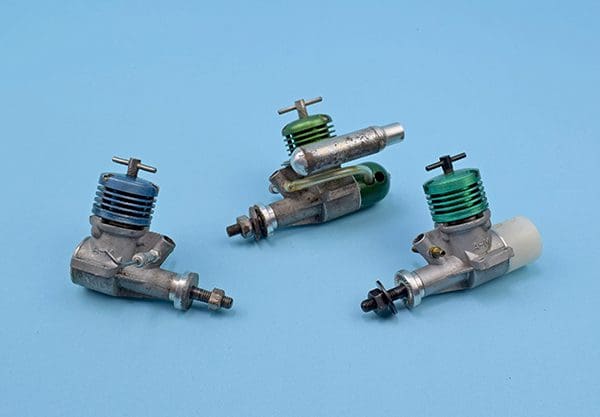
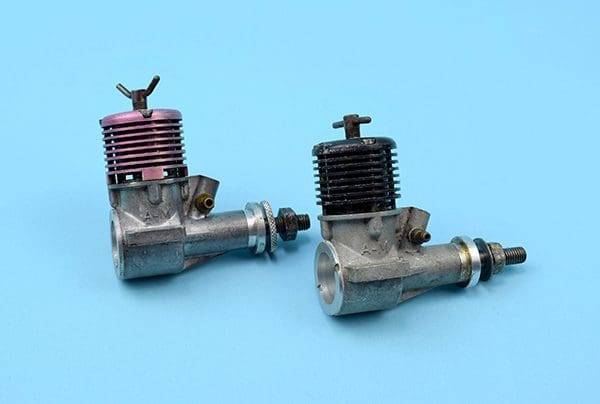
Remember Merco? Well, the owners approached Dennis with a proposal to buy their business that was currently manufacturing the Merco 29 and 35. In 1960 AM introduced a small 0.049 glow into the range but it wasn’t an AM product, just a re-badged Wen-Mac with their logo on the crankcase. Time progressed and Dennis decided he needed a new direction, so he let his business partner run AM and he started manufacturing glow plugs.
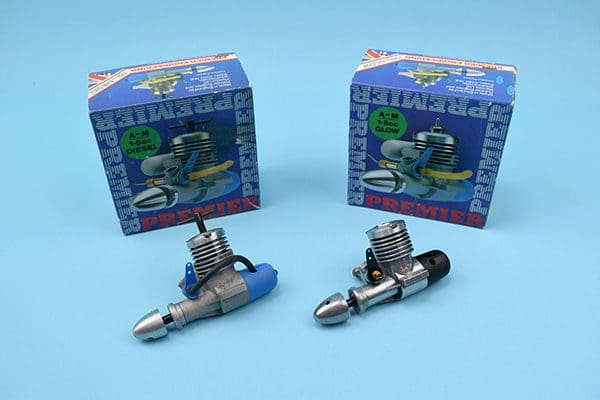
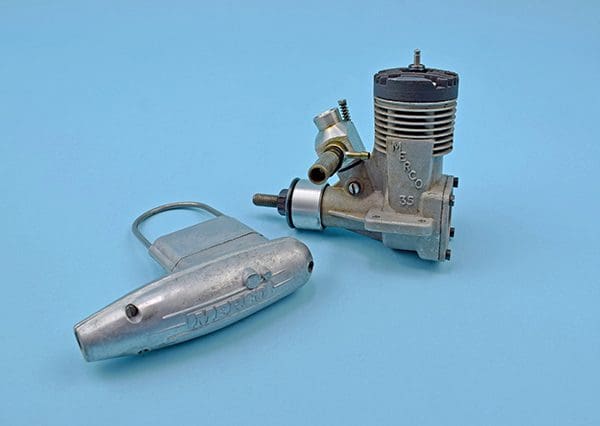
Subsequently the business was sold a couple of times, ending up under the ownership of Premier Engines & Plastics Ltd who offered updated versions of the AM10 and 15, and also in glow and R/C versions. The last engines to be manufactured, as far as I’m aware, were the exquisite AE 0.1cc, 0.2cc, 0.5cc, 1.0cc, 1.5 and 2.5cc diesels. They didn’t use castings but were machined from bar stock and anodised black. Irvine Engines were responsible for distributing these to the trade.
Another engine that Dennis designed in the early part of the 1980s was the Condor 4 Stroke, available in 0.91 and 1.20 cu. ins. (15 and 20cc). Around 500 or so were made but due to the not insignificant production costs they were discontinued. This was a real shame as it represented excellent value for money, especially when compared with the equivalent OS models of the day, being significantly cheaper.
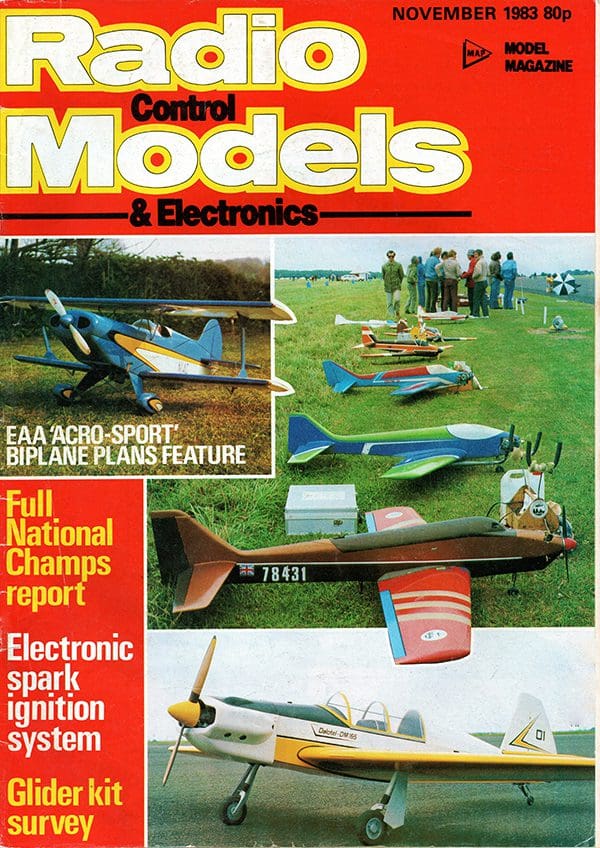
Dennis also designed a couple of 4 Stroke motors, the Condor 90 and 120. They were reviewed in RCM&E by Peter Chinn in his ‘Radio Motor’ column. Sadly, Condors were not a great commercial success with only around 500 sold.

Retro TX – another way
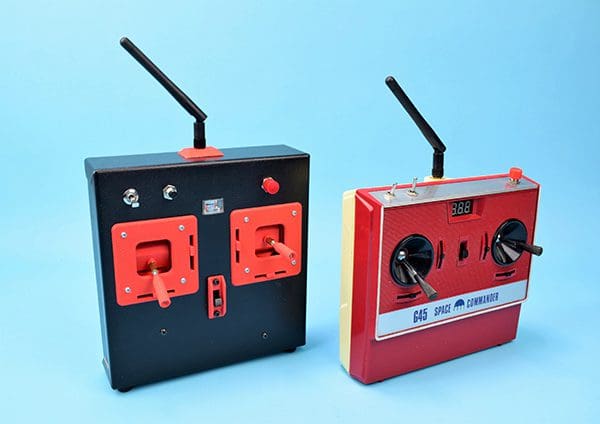
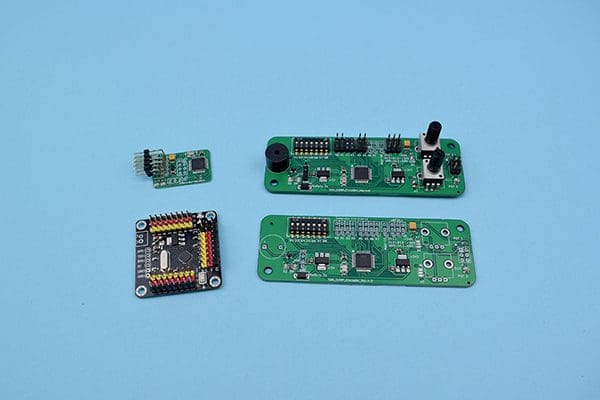
I noted in my last Ramblings column that there had been a blip in the availability of 2.4g plug in and DIY (Hack) modules for fans of retro transmitter conversion, but Lemon have now brought out some excellent new units, plus FrSky is available again.
Due to the initial drought of modules and, clearly having too much time on his hands, my mate Phil decided to design and build his own Arduino based 2.4g, seven function, full range channel hopping set from scratch during lockdown one. Hearing about this, Tobe (designer of the Quickie Ghost, 3D printed replica Adams, Rand and World Engines styled galloping ghost actuators) remembered that back in the old days, unless you were landed gentry, if you wanted to fly R/C you built the lot – including folding up the case and making stick units. This inspired him to go the extra mile and design his own open gimbal 3D printed sticks and servos using Phil’s electronics, so he would have a truly home built DIY radio set.
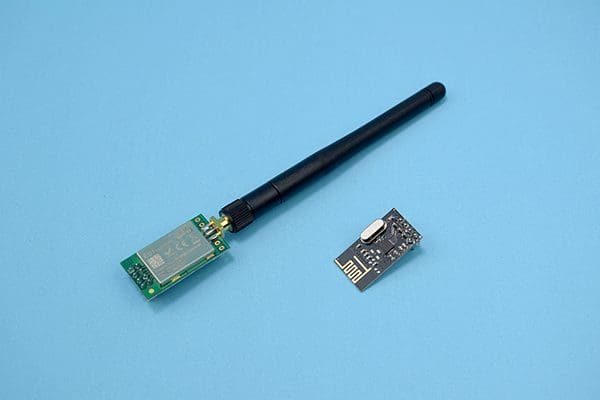
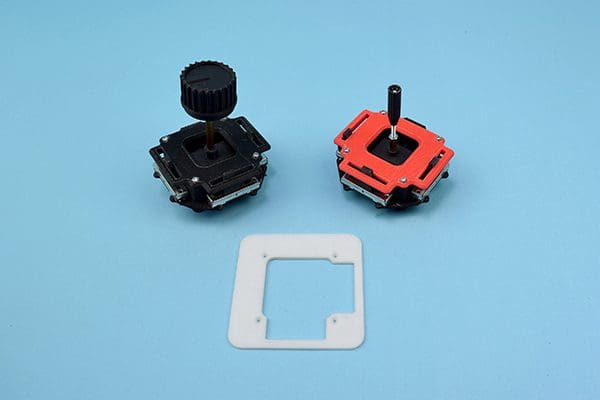
After having made a few examples for Galloping Ghost and Propo using off the shelf Arduino boards, he decided to take it a step further by designing a bespoke board for the Tx and another one for the Rx. However, there was a problem – he had never used PCB design software. In fact, Tobe was a mechanical engineer, not trained in electronics or software, but our intrepid Swede wasn’t put off by this minor setback and after many hours at the keyboard he became in his words ‘a reasonably competent happy camper’.
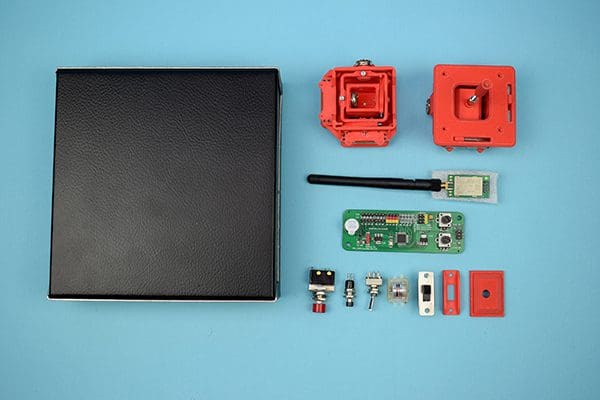
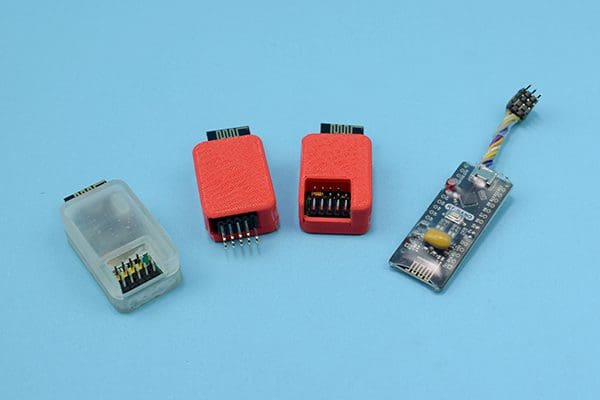
There was one final gap though. Initially, Tobe used an old amplifier from a Kraft servo to power his 3D printed servo but after a chat with another electronics wizard, Mike Kitchen, who analysed the output of the amp, he then replicated it in software again using an Arduino; result, one bespoke servo amp for Tobe!
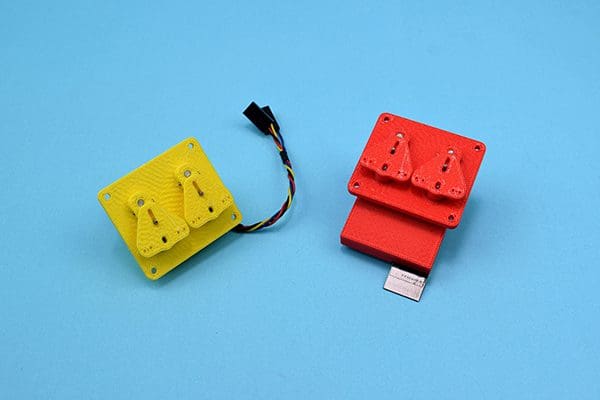
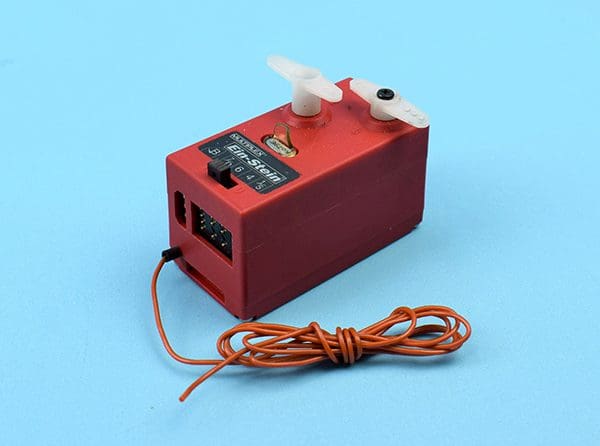
I’ll let Tobe wrap this up. I wish my Swedish was 5% as fluent as his English:
“The nRF24 module, which is the heart of the system, is a readily available and certified 2.4 GHz Tx / Rx unit. But, of course, we also need to have a brain and that is an Arduino processor i.e., 328P and these two units communicate with each other thanks to Phil Green’s work and so the DIY set came to life. The system has been tested for over a year and it is completely reliable, so that is what I fly with today for almost all my models, from the smallest to the largest, including my old ‘nostalgic’ F3A pattern ship.
Phil’s system has one major difference from regular FHSS systems; it does not need any bind between the Tx and Rx as the unique ID code is set in the software. So, the connection is immediate, allowing you to even switch the Tx during a flight as long the unique ID is the same. This reflects a little of what was possible with our equipment before 2.4 GHz took over.
Lastly, I had to come up with a ‘regular’ 3D printed servo, which I have called the ProPo. It comes in different versions, single or twin, with the twin having the option of a built in Rx (not unlike the old Multiplex Ein Stein Brick). And, yes, I have cut and bent all my Tx cases from 1 mm aluminium the old fashion way!
The DIY R/C set is based on Phil Green’s nRF24 project and is well described on mode-zero, which makes it unique as both software and hardware are done by amateurs just for fun and willing to see how far we could stretch the bow. It is available to everyone but please, if you use it, give the right credits.’
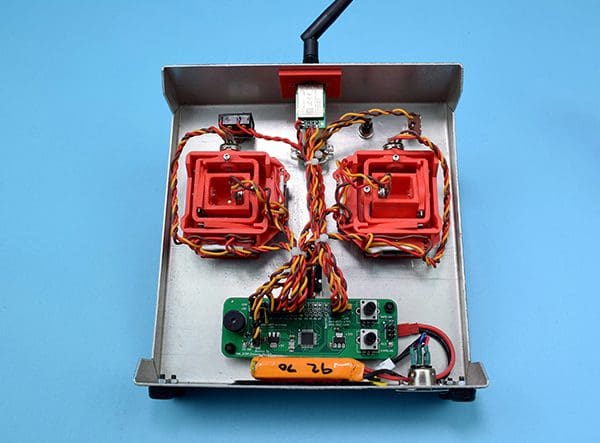
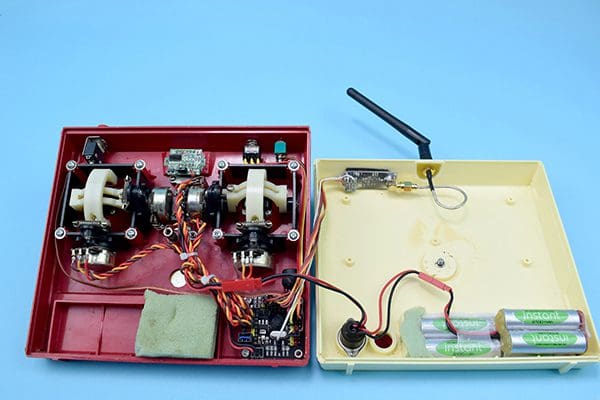
You will find in depth detailed info for this project on www.mode-zero.uk
So that wraps up this Ramblings. I have a busy time ahead as next weekend is our 9th Retro & Single Channel event and unfortunately it doesn’t organise itself. On top of that I am trying to get my Veron Hawker Tomtit completed and flight ready, then there’s the stack of LiPos to charge and models to safety check before committing aviation. I’ve ordered good weather so fingers crossed it will be another memorable event. I will have my camera at the ready for a future event report.
As always send your stories, musing, photos etc. to: [email protected]
